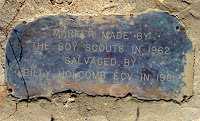Vallecito and The Lady Ghost in White
June 22, 1993
San Diego County. First in a series (or last on a blog) of nine landmarks visited, and though not one that tends to believe in such things as ghosts..........
James Lassator built a sod house here in the early 1850’s as a stopping place at the first good water in quanity and grasses along the southern emigrant trail from
Yuma.
The house became a station for the San Antonio-San Diego mail route known as the ‘Jackass Mail’, and later for the Butterfield Overland Mail and in its reconstructed state, remains one of the chief landmarks of the line.
These stations were the only relief for the rigors of travel and the scenes of countless events of dramatic interest that have left numerous ghost stories; the ‘White Horse Ghost of Vallecito’, the ghosts of Texas emigrants Mr.’s Buck and Roland who shot it out to their deaths, and the ‘Lady Ghost’ or ‘White Lady of Vallecito’, and it is she that makes the vistor most uncomfortable.
Buried in her wedding dress just below the station, they thought they had put her to rest but almost every night it is said she rises from her grave to walk the floors of Vallecito Station waiting for the stage to take her on to her lover in
Sacramento and a marriage that never materialized.
NO. 304 VALLECITO STAGE DEPOT (STATION) - A reconstruction (1934) of Vallecito Stage Station built in 1852 at the edge of the Great Colorado Desert. It was an important stop on the first official transcontinental route, serving the San Diego-San Antonio ('Jackass') mail line (1857-1859), the Butterfield Overland Stage Line, and the southern emigrant caravans.
Location:
Vallecito Stage Station County Park, on
County Rd S2 (P.M. 34.7), 3.7 mi NW of Agua Caliente Springs 32º58.543'N - 116º21.002'W
Though not one to believe in ghosts, there is something spooky about this place, and there is no wish to spend a night here alone.
The song 'Vallecito' came as part of the Southern Emigrant Trail project and here's a link to a video sample:
VALLECITO © Radio Flier Music
Vallecito, little valley, your water tastes so fine
Salt grasses for the horses, cool shade from the pines
In the late 1850's when the Butterfield line was new
A young girl came from the East, for her fiancé so true
Up to the gold country diggings where he'd made a lucky find
Eileen O'Connor would meet her lover and there to be his bride
Vallecito, little valley, your water tastes so fine
Salt grasses for the horses, cool shade from the pines
Improper food and doubtful water and the desert took its toll
She was too weak for the hardship, Eileen had taken ill
When they finally reached the station she was carried from the stage
Sweet water of Vallecito could not this young girl save
Vallecito, little valley, your water tastes so fine
Salt grasses for the horses, cool shade from the pines
They found her wedding dress and her letters they would send
This lost daughter of the golden west had come to journey's end
In the moonlight you can see her, pacing the Vallecito night
Waiting for the stagecoach, the lady ghost in white
Vallecito, little valley, your water tastes so fine
Salt grasses for the horses, cool shade from the pines
It's a long and rugged journey, on the Southern Emigrant Trail
Your sweet water came too late, for the girl so young and frail


















































